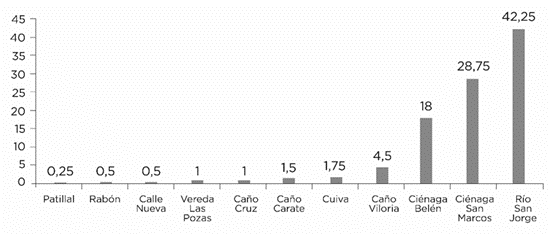INTRODUCTION
Fish consumption in the riparian and coastal areas of Colombia is considerably high, representing a large proportion of the animal protein consumed (DNP, 2012). In turn, various studies have reported high levels of Hg contamination in fish from these areas, especially where artisanal-scale gold mining activities have been practiced (Marrugo-Negrete et al. 2018). An important riparian region that serves as a reference to measure the levels of Hg contamination in Colombia is La Mojana, a region located in the north of the country and where three large Colombian rivers converge: Cauca, Magdalena, and San Jorge. Through the channels of these rivers, large quantities of Hg are discharged from the gold mining practiced in the south of Bolívar, north of Antioquia, and the upper part of the San Jorge river. Located in the south of the department of Sucre, the municipality of San Marcos is part of the region of La Mojana and San Jorge, it has numerous bodies of water, that host great biodiversity, made up of species of phytoplankton, zooplankton, periphyton, macroinvertebrates aquatic animals, plants, terrestrial invertebrates and vertebrates (Linares Arias et al. 2018). These water bodies also provide ecosystem services to the population, including the consumption of fish from rivers and swamps near the municipality. In a study carried out by Marrugo-Negrete et al. (2018), it was shown that 11.6% of the fish species evaluated exceeded the recommended limits for Hg of 0.5 (UE) and 0.2 µg/g (FAO/WHO).
The environmental levels of Hg have increased considerably since the beginning of the industrial era, it is present throughout the planet in various sources and foods, especially in fish, at harmful levels to humans and wildlife (Buck et al. 2019). It is a toxic metal, which can be chemically transformed, accumulated, and biomagnified in the trophic chain (Liu et al. 2021), until it reaches man, causing neurological damage, irritation of the gastrointestinal tract, and kidney and liver deterioration (Rice et al. 2014). It exists in a wide variety of forms, particularly as organic mercury compounds (Clarkson & Magos, 2006). The best known of all is methylmercury (MeHg), formed in the environment by microbial metabolism and abiotic processes (Bravo & Cosio, 2019), in addition, since most of the Hg is present as MeHg in aquatic biota (Gimenes et al. 2021), is classified as the main source of human exposure due to fish consumption (Mania et al. 2012).
MeHg is formed by the methylation of inorganic Hg carried out by microorganisms present in the soil, in sediments, in the air, or underwater (Ma & Wang, 2019), to later pass to the trophic network and be bioaccumulated and biomagnified, up to the human being (Li et al. 2021).
In pregnant women, MeHg crosses the placenta and is concentrated in the fetus; congenital disease affects newborns and translates into cerebral palsy with mental retardation, feeding difficulties, and significant motor deficit, in less severe cases, they can appear completely normal and develop neurological deficit once the central nervous system matures (Saavedra et al. 2021). Methylmercury also has a teratogenic capacity (Hong et al. 2012). Teratogenicity consists of alterations in the development of the embryo or fetus, which can generate congenital malformations (Rojas & Walker, 2012).
For this reason, the evaluation of MeHg levels represents an important factor not only from a toxicological point of view but also for the evaluation of potential impacts on public health. The municipality of San Marcos was chosen to carry out this research because it has one of the most important urban populations and economies in La Mojana. Therefore, the objective of this research was to determine the concentrations of MeHg in the most consumed fish species in the Municipality of San Marcos, Colombia.
MATERIALS AND METHODS
Study area. The present study was carried out in six sampling sites in wetlands, streams, and rivers adjacent to the municipality of San Marcos 8°35'06''N, 75°07'16.39''W, located south of the department from Sucre, gateway to the sub-region of La Mojana, northwestern Colombia. The sampling sites were San Marcos Swamp, Carate Stream, Viloria Stream, San Jorge River, Belén, and Palo Alto Swamp (Figure 1). These sampling sites were chosen because they are streams and swamps that receive water from the San Jorge River downstream and run along the jurisdiction of the municipality of San Marcos. Two systems can be established in the area: the floodplain of the Lower San Jorge River (swamps and swamp complexes), made up of about 400 bodies of water, of which the municipality has a total of 49; and that corresponding to the basin of the lower San Jorge River, made up of the river and innumerable streams that drain from the eastern slope of the Serranía de San Jerónimo and converge on the left bank of the San Jorge River (IGAC, 1986).
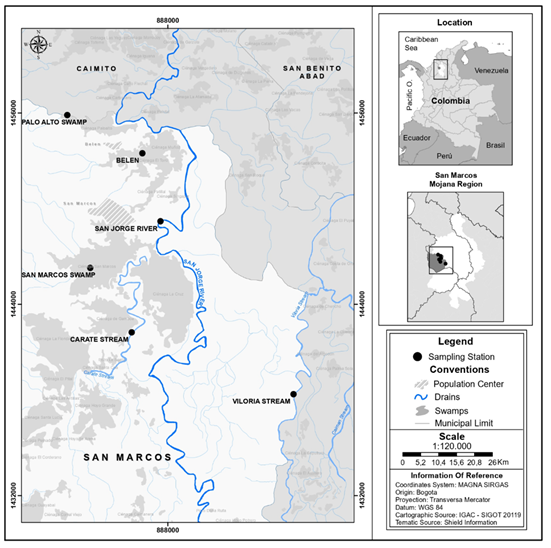
Figure 1 Map of the sampling areas to determine the concentrations of MeHg in the most consumed fish species in the municipality of San Marcos, Colombia.
Samples collection. Previous design and validation, a survey was applied to 100 individuals to collect information on eating habits in the municipality. Subsequently, supported by the information from the surveys, the fish species of interest for the study were captured, with the help of fishermen in the area. 10 individuals per species were captured, for a total of 110 individuals. The fish were caught in six bodies of water that surround the municipality of San Marcos. The viscera were extracted from the captured fish. Subsequently, samples of the dorsal muscle of the fish were taken. and then they were individually packed in plastic bags and transported in a cold chain to the Water, Applied and Environmental Chemistry laboratory of the University of Córdoba where the dorsal muscle was used to quantify the MeHg. The fishes were identified with the book of Mojica et al. (2012).
MeHg analysis in fish dorsal tissue. To carry out the quantification of MeHg, 0.3-0.5 g of fresh fish was digested with hydrobromic acid using a 50 ml centrifuge tube through of manual shaking. Subsequently, 20 mL of toluene was added and the resulting mixture was stirred for 2 minutes. Afterward, the mixture was centrifuged for 10 min at 3000 rpm and then 15 mL of the upper organic phase was extracted several times into 50 mL tubes containing 6.0 mL of 1% L-cysteine solution. Finally, a 100 µL aliquot of the aqueous phase was injected into a direct mercury analyzer (Cordeiro Raposo et al. 2013). Quality control was carried out in triplicate using CRM DORM-2 certified standard dogfish muscle (4.47 ± 0.32 µg/g). The MeHg recovery percentage was 99.0 ± 3.7% (n = 3), the detection limit was 0.007 µg g-1, and the quantification limit was 0.023 µg g-1. MeHg concentrations were reported in µg kg-1 wet weight (ww). Analyzes of fish samples for MeHg were done in duplicate.
Statistical analysis. The Kolmogorov - Smirnov normality test was performed to verify the assumption of normality of the MeHg concentrations obtained, subsequently, an analysis of variance (ANOVA) was performed using the Tukey test. In this sense, the homogeneity of the sample variances was corroborated by Bartlett's homoscedasticity test of variances; obtaining the concentrations of MeHg for each species studied as the mean ± the standard deviation of the same, in the same way, all the tests were carried out with a significance level of 95% (p <0.05). The data treatment was carried out with the statistical packages Statgraphics Centurion version 15.2.06 and Infostat3.
RESULTS AND DISCUSSION
The fish species with the highest consumption, the mean concentrations of MeHg determined in their dorsal muscle and the average weekly consumption of the surveyed individuals are shown in Table 1. Pseudoplatystoma magdaleniatum and Prochilodus magdalenae presented the highest and lowest mean concentration of MeHg, respectively and P. magdalenae and Ageneiosus pardalis were, in their order, those with the highest and lowest consumption. The average concentration of Hg in fish in the present investigation was 0.221 μg/g. This result is lower than that found by Marrugo-Negrete et al. (2018), in 13 species from the study area, who obtained a mean Hg concentration of 0.270 μg/g. Marrugo-Negrete et al. (2020) determined concentrations of mercury and methylmercury (MeHg) in the 10 most consumed fish species in 11 municipalities of La Mojana, obtaining concentration ranges between 0.22-0.58 μg/g in carnivorous fish, concentration ranges higher than those found in carnivorous fish in this investigation, which were between 0.173 μg/g and 0.396 μg/g. Marrugo-Negrete et al. (2010) determined Hg-T concentrations in fish, being the highest in the carnivorous Pseudoplatystoma magdaleniatum, and the lowest in the non-carnivorous Prochilodus magdalenae, results that coincide with those found here. Figure 2 shows the distributions of the MeHg concentrations in the evaluated species.
Table 1 Mean concentrations of MeHg (µg/g) in fish species consumed in San Marcos with eating habits and mean weekly consumption (g/week).
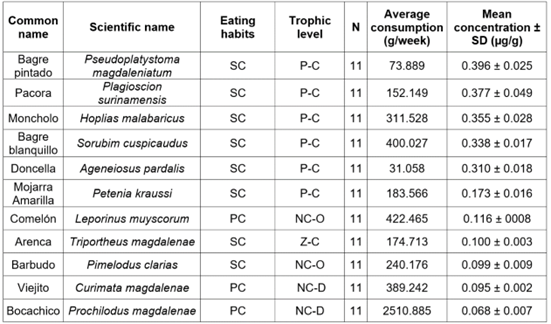
SC: Secondary consumer. PC: Primary consumer. P-C: Piscivorous carnivore.
Z-C: Zooplanktophagous carnivore. NC-O: Non-carnivore omnivore. NC-D: Non-carnivorous detritivore.
The fish species that are consumed in San Marcos come from places close to the urban area, with the San Jorge River, San Marcos and Belén Ciénaga Swamp being the sites from which the largest supply of fish comes for such consumption. However, there are other sites from which this food is also extracted to a lesser extent, such as Viloria Stream, Cuiva, Patillal, village of Las Pozas, Calle Nueva, Rabón, Caño Cruz, and Carate Stream, as shown in figure 3.
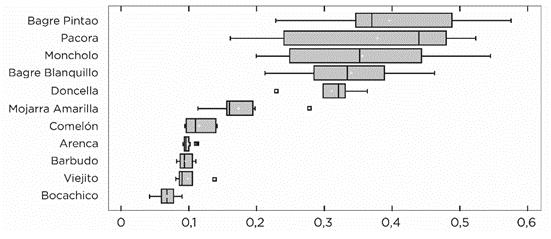
Figure 2 Distribution of methylmercury concentrations in the fish species with the highest consumption in the municipality of San Marcos, Sucre.
The most consumed fish by the inhabitants of San Marcos were P. magdalenae, Leporinus muyscorum, and Sorubim cuspicaudus, this is due to their great abundance, low commercial value, and culture of consumption (Atencio et al. 2013; Segura-Guevara et al. 2017), those with the lowest consumption were P. surinamensis, P. magdaleniatum and A. pardalis. P. magdaleniatum is the second species with the lowest consumption by the inhabitants of San Marcos, this situation originates because the meat of this fish has a high commercial amount in local markets, due to the wide acceptance among consumers for its nutritional value and absence of intramuscular spines (Márquez-Fernández et al. 2020).
The presence of MeHg in fish depends on the type of diet or eating habits of the fish species since this pollutant is biomagnified through the food chain. Therefore, predatory species, secondary and tertiary consumers, contain higher levels of mercury in their tissues than non-predatory species, primary consumers (Lavoie et al. 2013). The fish species with the highest concentration of MeHg are P. magdaleniatum, P. surinamensis, Hoplias malabaricus, S. cuspicaudus, and A. pardalis; this is a group of predatory species that have a carnivorous diet, characterized by including other smaller fish and some benthic invertebrates in their diet (Marrugo-Negrete et al. 2007). In figure 2, the lower part shows a group of species with a lower degree of MeHg concentration, these correspond to Petenia kraussi, L. muyscorum, Triportheus magdalenae, Pimelodus clarias, Curimata magdalenae and P. magdalenae; the latter being the species with the lowest concentration of MeHg (0.068 ± 0.007 ug MeHg/g), a result that occurs because the P. magdalenae is not a predatory species, it feeds on organic matter, and its diet is made up mainly of detritus containing algae, bacteria and fungi (Ramírez Caballero & Pinilla Agudelo, 2012). In the upper part of figure 2, the first group of species with high variability in the concentration of MeHg is evidenced and in the lower part of the same figure 2, the second group of species with less variability in the concentration of MeHg is observed. This is explained from the point of view of the mobility regime of each of these species. In the first group, P. magdaleniatum, P. surinamensis, S. cuspicaudus are cataloged as migratory species, these fish at a certain point in their biological cycle feel the impulse to reproduce, which induces them to carry out tours in search of places that meet the conditions minimum for their vital function, migrations begin from mid-December to mid-March (Jiménez-Segura et al. 2010; Zapata & Usma, 2013). Unlike the second group, where T. magdalenae and C. magdalenae are classified as non-migratory species, these fish perform their vital functions mainly in swamps, which indicates that they have a lower mobility regime and therefore less variability in the concentrations of MeHg (DoNascimiento et al. 2017). P. clarias and P. magdalenae, despite being migratory species, presented low levels and variability of methylmercury. On the other hand, H. malabaricus presented high levels and high variability of the pollutant. These cases can be explained because the biomagnification and bioaccumulation process of Hg in fish depends on many factors related to the type of species, its physiology, its ecology, and the physicochemical factors of the water bodies in which they live (Lescord et al. 2019).
Hg and MeHg concentration in sediment from the sites where most of the fish consumed in the Municipality of San Marcos come from is observed in table 2. Table 2 shows the low variability of MeHg concentrations in sediment from the different sampling sites. Viloria Stream was the place where the sediment samples registered the highest concentration of the pollutant (0.007 µgMeHg / g). This value is lower than the 0.097 μg/g of THg in sediments reported by Marrugo-Negrete et al. (2018) and the 0.5242 μg/g, reported by Pinedo-Hernández et al. (2015), in the study area. This stream connects the Ayapel swamp with the San Jorge River (Argumedo G. et al. 2015). The Ayapel swamp is affected by nickel mining carried out in the upper San Jorge, and through sewers, it receives mercury contamination from the north of Antioquia, Bajo Cauca, and south of Bolívar. The dynamics of mining waste in the area are as follows: The mercury used for gold extraction flows through the Magdalena, San Jorge, and Cauca waters to the Ayapel swamps and the pipes connected to it. Hg is deposited in the sediments and from these, it passes to macrophic plants and small fish, on which larger fish and organisms of other taxa will feed. (Marrugo-Negrete et al. 2010).
Table 2 The concentration of Hg and MeHg in sediments from the sites of origin of the fish species with the highest consumption in San Marcos, Sucre.
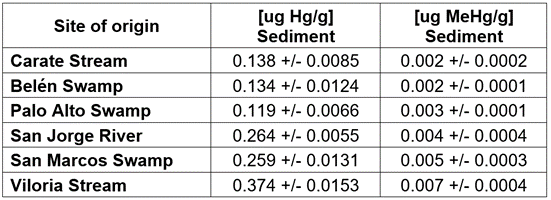
The results obtained confirm the presence of methylmercury in all the fish samples consumed in the population of San Marcos, thus demonstrating that the organometallic forms of mercury are more easily accumulated by the aquatic biota, due to the ease of diffusion in their cell membranes and the affinity of compounds with body lipids (Ajsuvakova et al. 2020). Mercury in fish is neurotoxic (Pereira et al. 2019) and high levels of the metal can cause pathological and biochemical changes, reproductive problems, less food consumption and decreased alertness to predators, threatening their ability to survive (Strungaru et al. 2018). Mercury is teratogenic and its effects can damage genes, proteins, cells, and tissues, and affect the growth and behavior of fish, it produces oxidative stress (Zheng et al. 2019), immune deficiencies (Abu Zeid et al. 2021), alterations hematological and biochemical (Alam et al. 2021), affects sperm quality and fish fertility (Hayati et al. 2019) and produces hepatoxicity (Brandão et al. 2015).
The consumption of species contaminated with MeHg causes problems for human health, especially for the most vulnerable groups, such as pregnant women, babies, children, and malnourished people (Gimenes et al. 2021). Chronic exposure to low doses of MeHg causes cardiovascular problems, fetal neurological damage, neurological disorders, and brain development (Yu et al. 2020).
According to the maximum methylmercury concentration limit in fish of 0.5 µg / g, set by FAO and the World Health Organization (FAO / WHO, 2007), none of the species had mean concentrations above this value. However, due to the constant consumption by the population of this region of the aforementioned fish, it presents a health risk.
In conclusion, the fish species with the highest consumption in San Marcos - Sucre, present contamination by MeHg, caused by mining and the use of agrochemicals in the region of La Mojana. This puts the region's fish diversity at risk and puts human populations at risk due to their consumption. Constant monitoring of Hg contamination levels in the area and environmental policies are recommended to avoid the excessive dumping of heavy metals in the Mojana region.
Since the problem of contamination by MeHg of the fish consumed in La Mojana has its main source in gold mining, it is recommended that government entities provide technical assistance to artisanal miners for them to formalize their mining activities and make them more competitive, productive, and more eco-friendly.














